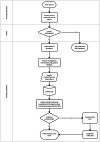Nursing leadership visits for real-time patient experience enhancement: a cross-sectional study of tertiary hospital care in Brazil
- PMID: 41152844
- PMCID: PMC12560590
- DOI: 10.1186/s12912-025-03989-8
Nursing leadership visits for real-time patient experience enhancement: a cross-sectional study of tertiary hospital care in Brazil
Abstract
Background: The quality of hospital care and patient experience are pillars of healthcare delivery. Nursing leadership visits have emerged as a management strategy to monitor and enhance these aspects in real time. The objective of this study was to evaluate nursing leadership visits as an instrument for measuring the quality of hospital care provided in a philanthropic tertiary hospital in São Paulo, Brazil.
Methods: This retrospective study analyzed data from Nursing Leadership Visits conducted from July 2023 to December 2024. Initially, the institutional database contained approximately 8,500 records. A total of 7,707 eligible Nursing Leadership Visits were included, excluding visits performed by nurses not in leadership positions. Data were summarized using absolute and relative frequencies (%), in addition to descriptive statistics (mean, standard deviation, median, minimum, and maximum) for Likert scale variables. Patients were classified as promoters (score 9 or 10), neutrals (score 7 or 8), or distractors (score 0 to 6) on the basis of the net promoter score. No inferential analyses were performed.
Results: A total of 7,707 eligible Nursing Leadership Visits were analyzed. The average net promoter score calculated from these visits was 95.6%, with 97.07% of patients classified as promoters, 2.78% as neutrals, and 0.16% as distractors. The average process and environment compliance rate was 97.6%. Nursing management interventions were required in 1,293 (16.78%) of the visits, with 767 (59.32%) of them being resolved during the visit itself. The analysis of patient experience dimensions demonstrated that, while high scores predominated, the instrument was capable of identifying areas for improvement, especially in the evaluations of neutral and distractive patients.
Conclusion: The reformulated Nursing Leadership Visit is an effective and indispensable instrument for managing the quality of hospital care. Its implementation fostered an evidence-based management approach, facilitating strategic decision-making and contributing to the establishment of a culture of continuous improvement through immediate intervention and a focus on real-time patient experience.
Supplementary Information: The online version contains supplementary material available at 10.1186/s12912-025-03989-8.
Keywords: Cross-sectional studies; Hospital administration; Patient experience; Patient satisfaction; Quality of health care.
Conflict of interest statement
Declarations. Ethics approval and consent to participate: The present study was conducted in accordance with the Declaration of Helsinki and adhered to the applicable Brazilian Resolutions on research involving human beings. The research protocol was initially reviewed and approved for feasibility by the Technical Research Chamber of the New Knowledge Nucleus of the Hospital Sírio-Libanês Assistance Directorate. It was subsequently approved by the Education and Research Directorate of Hospital Sírio-Libanês (Project ID HSL 3060). Finally, it was submitted to and formally approved by the Human Research Ethics Committee – São Paulo (Comitê de Ética em Pesquisa com Seres Humanos – São Paulo - CEPesq–SP), of Sociedade Beneficente de Senhoras Hospital Sírio-Libanês (the proposing institution), under the approval protocol number CAAE: 68671023.2.0000.5461 and the substantiated opinion number 6.048.425. The requirement for the application of the ICF was waived by CEPesq-SP, as provided in Item IV.8 of Resolution nº 466/2012 of the Brazilian National Health Council (Conselho Nacional de Saúde). This waiver was granted because the project has a retrospective design, involving the collection of a large volume of patient data from the institution’s electronic health records, which would make it impractical to obtain individual consent from all participants. Additionally, the researchers committed to fully anonymizing the database before conducting the analyses, thereby ensuring the confidentiality of information and the privacy of patient data. The researchers involved committed to maintaining the confidentiality of all data. Consent for publication: Not applicable. This manuscript does not contain any individual person’s data in any form (e.g., details, images, or videos) that would require consent for publication. Competing interests: The authors declare no competing interests.
Figures


References
-
- Almeida HOC, Góis RMO. Avaliação da satisfação do paciente: indicadores assistenciais de qualidade. Rev Adm Saúde. 2020;20(81). 10.23973/ras.81.244. Accessed 03 Jan 2025.
-
- Wolf JA, Niederhauser V, Marshburn D, LaVela SL. Defining patient experience. Patient Exp J. 2014;1(1):7–19. 10.35680/2372-0247.1004. Accessed 03 Jan 2025.
-
- Donabedian A. The quality of medical care: how can it be assessed? JAMA. 1988;260(12):1743–8. 10.1001/jama.1988.03410120089033. Accessed 03 Jan 2025. - PubMed
-
- Costa DG, Moura GMSS, Moraes MG, Santos JLG, Magalhães AMM. Satisfaction attributes related to safety and quality perceived in the experience of hospitalized patients. Rev Gaúcha Enferm. 2020;41(esp):e20190152. 10.1590/1983-1447.2020.20190152. Accessed 03 Jan 2025. - PubMed
-
- Bernardo JMS, Mendes GHS, Lizarelli FL, Roscani MG. Instruments to measure patient experience in hospitals: a scoping review. Gest Prod. 2022;29:1–24. 10.1590/1806-9649-2022v29e0821. Accessed 05 Jan 2025.
LinkOut - more resources
Full Text Sources

